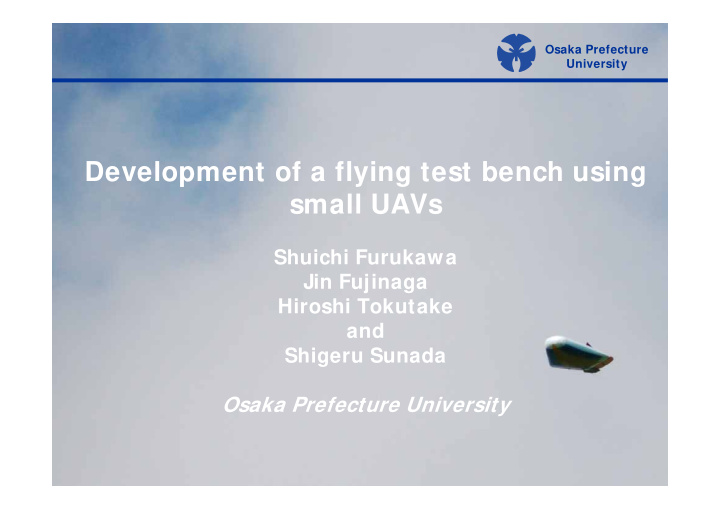



Osaka Prefecture Osaka Prefecture University University Development of a flying test bench using small UAVs Shuichi Furukawa Jin Fujinaga Hiroshi Tokutake and Shigeru Sunada Osaka Prefecture University
Osaka Prefecture Contents University 1.Motivation 2.Introduction 3.Design of lifting body aircraft 4.Wind tunnel experiments 5.Modeling of dynamics 6.Controller design 7.Design of navigation and guidance system 8.Numerical simulation 9.Flight test 10.Conclusions
Osaka Prefecture Motivations University 1.Experiments of the next generation Re-Entry Vehicles are expensive. ⇒ The research using a small model is more inexpensive. 2.Some UAVs realized an autonomous flight. ⇒ UAVs can be used as a test bench for an advanced flight control. A small Re-Entry Vehicle test-model with an ability of autonomous flight was developed.
Osaka Prefecture Introductions University 1. A Gliding UAV of lifting body was developed. 2 . The modeling of dynamics was constructed from the results of wind tunnel experiments. 3. Guidance-Navigation and control systems were designed. 4. Flight tests were carried out.
Osaka Prefecture Flight profile University The flight of Re-Entry Vehicle is divided into several phases . ⇒ Orbital Re-Entry phase, Hypersonic Flight phase, Landing Flight phase . Experimental research of Landing Flight phase 1. Lifting body design 2. Controller design 3. Navigation and Guidance system design Orbital Re-Entry phase Landing Flight phase Hypersonic Flight phase
Osaka Prefecture Lifting body aircraft University Span: 39cm Length: 42cm Weight: 350g Control surfaces: Elevons Tail: Vertical tail 394 Avionics bay Velocity: 6.4m/s(AOA=27 deg) Made of styrene foam 80 420 Figure 1. Designed aircraft model
Osaka Prefecture Wind tunnel experiments University Aerodynamics forces were measured . Wind velocity: 4m/s Angle of attack: 10-36deg Elevons angle: -5-15deg Reynolds number : ~10 5 Figure 2. Wind tunnel experiments
Osaka Prefecture Results of wind tunnel experiments University Drag coefficient Lift coefficient 1.6 1.2 Lift coefficient Drag coefficient 0.8 0.4 0 0 10 20 30 40 Angle of attack[deg] Figure 3. Lift coefficient and Drag coefficient Figure 4. Pitching moment coefficient Maximum L/D is 4.58. Pitching dynamics is statically stable.
Osaka Prefecture Modeling of dynamics University The linearized equations of motion were formulated. This gliding UAV was assumed to have a constant longitudinal forward velocity. Eigenvalues Longitudinal; = + δ & x A x B Longitudinal; lon lon lon lon e [ ] λ = − ± λ = − = α θ T 1 . 30 4 . 49 i , 0 . 66 x q sp ph lon Lateral-directional; Lateral-directional; λ = − λ = − ± = + δ & 4 . 03 , 0 . 92 7 . 83 i x A x B roll Dutch roll lat lat lat lat a [ ] λ = = β φ T 0 . 73 x p r spiral lat Trim conditions; ⇒ There is no pair of complex values for the phugoid mode. Velocity: 6.4 m/s Angle of attack: 27deg ⇒ Spiral mode is unstable. Path angle: -25deg
Osaka Prefecture Controller design (longitudinal dynamics) University Design requirements; 1. Robust stabilities subject to multiplicative uncertainties at output side are ensured. 2. Responses to longitudinal gust are suppressed. 3. Deflection angles of elevons are suppressed. Figure 5. Block diagram for longitudinal dynamics H-infinity controller was obtained. H-infinity norm of the transfer function from disturbances to controlled outputs was minimized.
Osaka Prefecture Controller design (lateral-directional dynamics) University Design requirements; 1. Robust stabilities subject to multiplicative uncertainties at input side are ensured. 2. Responses to lateral-directional gust are suppressed. 3. Deflection angles of elevons are suppressed. Figure 6. Block diagram for lateral-directional dynamics (Lateral-directional inner loop) 4. Sensor noises are taken into account. H-infinity controller was obtained. H-infinity norm of the transfer function from disturbances to controlled outputs was minimized.
Osaka Prefecture Navigation and guidance system University Figure 7. Guidance system � The guidance and navigation system attained a waypoint tracking. � Bank command was determined by heading error using PID controller. � Bank command was input to lateral-directional inner-loop system.
Osaka Prefecture Numerical simulations University Longitudinal responses to gust disturbances were simulated. without controller with controller 0.3 0.3 0.2 0.2 q [rad/sec] 0.1 0.1 α g [rad] 0 0 -0.1 -0.1 -0.2 -0.2 -0.3 -0.3 0 2 4 6 8 10 0 2 4 6 8 10 Time [sec] Time [sec] Figure 8. Input gust component Figure 9. Response of pitch rate The designed controller decreases the pitching rate caused by the gust.
Osaka Prefecture Flight tests University Altitude was 200m. Launch Waypoint tracking Landing
Osaka Prefecture Avionics University GPS Onboard Rate gyro ( 3 axes) Accelerometer (3axes) Geomagnetism sensor RC receiver Barometric altimeter Wireless modem Flight computer MAVC1 Weight: 29g, size:75mm × 55mm A/D 6ch D/A 2ch PWM 8ch CCP 10ch I/O 16ch Serial 4ch Servo motor Servo motor GPS 1ch Geomagnetism sensor 1ch Rate gyro (3 axes, onboard) Accelerometer (3axes, onboard)
Osaka Prefecture Results of the flight tests (1) University The heading was maintained to point to west. ⇒ Error of heading angle was controlled to zero. Launch altitude: about 35m Wind: 4m/s from west � The steady glide was attained. � The heading was stabilized nearly at the desired heading direction. Figure 10. Heading angle tracking
Osaka Prefecture Results of the flight tests (2) University The UAV was controlled to track given waypoints. Launch altitude: about 200m Wind:1m/s from east on the ground Figure 11. Waypoint tracking record Figure 12. Altitude record � Steady glide was attained. � The UAV passed through the desired waypoints.
Osaka Prefecture Results of the flight tests (movie) University
Osaka Prefecture Conclusions University 1. Lifting body aircraft was developed for landing flight phase. 2. The modeling of the dynamics was constructed from Wind tunnel experiments. 3. The robust controllers were designed, and gust responses were suppressed. 4. Navigation and guidance system was designed 5. Flight tests were carried out. FUTURE WORKS � Flight systems for several trim conditions are designed. � The controllers per altitude are scheduled. � The flight tests at higher altitude are performed . � The other flight phases are challenged.
Recommend
More recommend